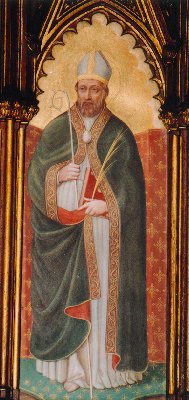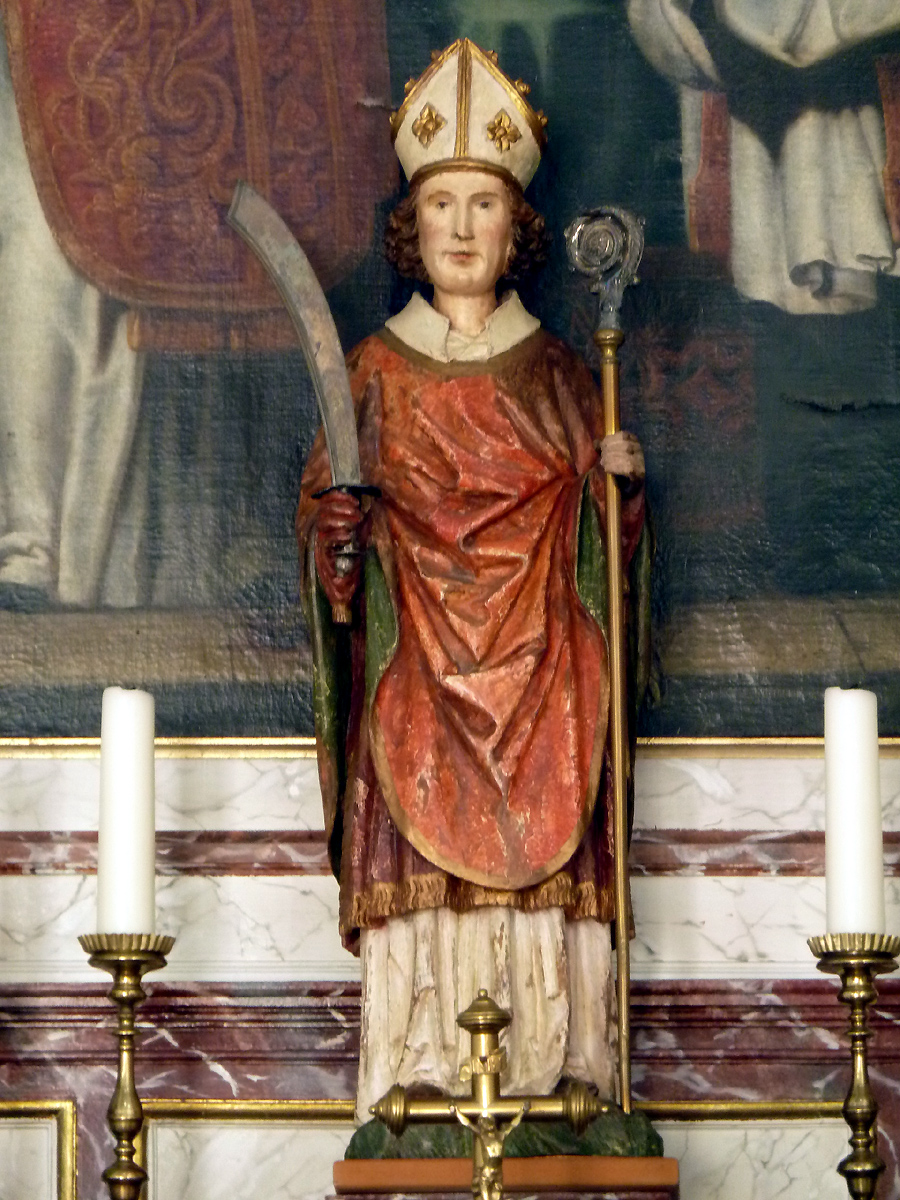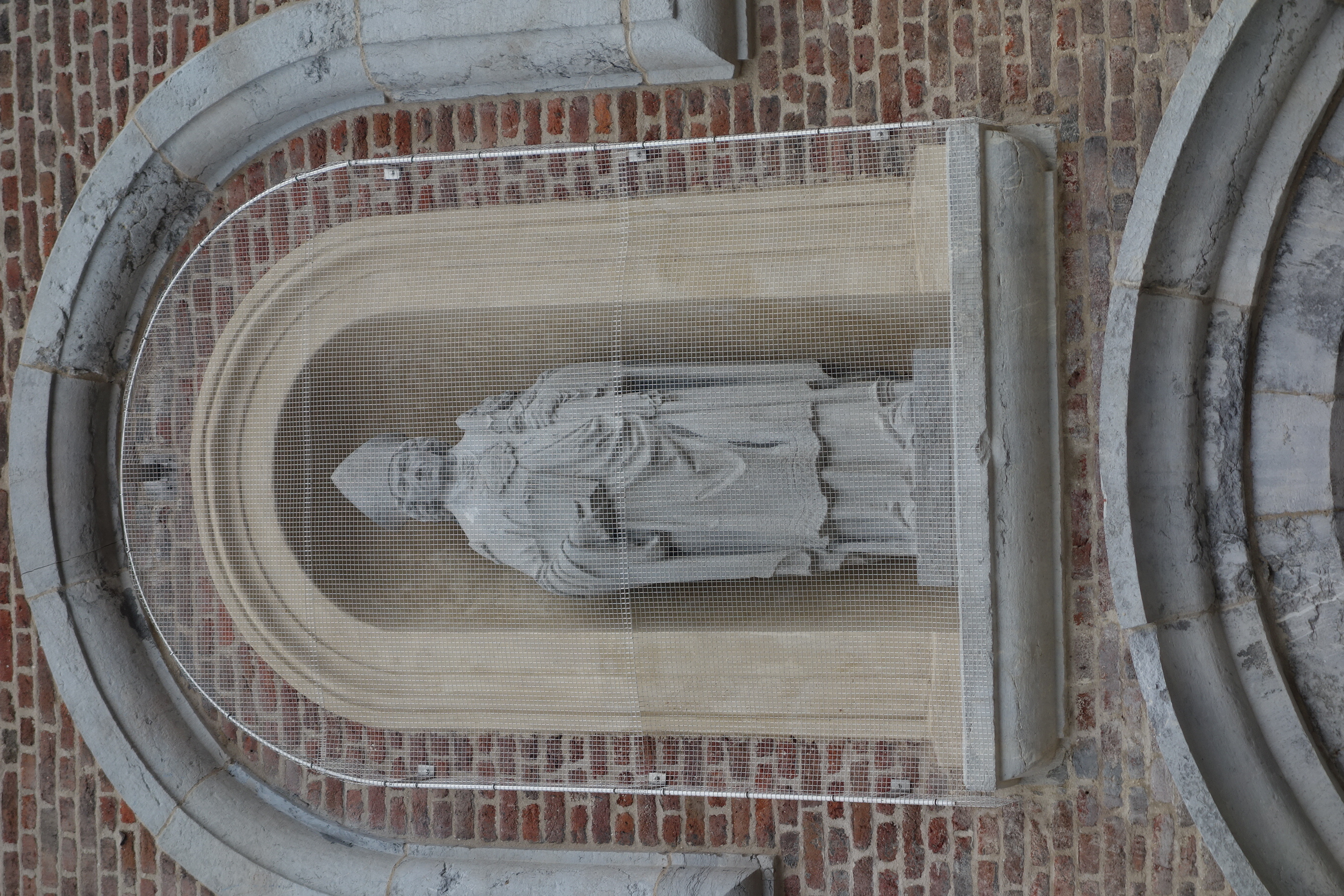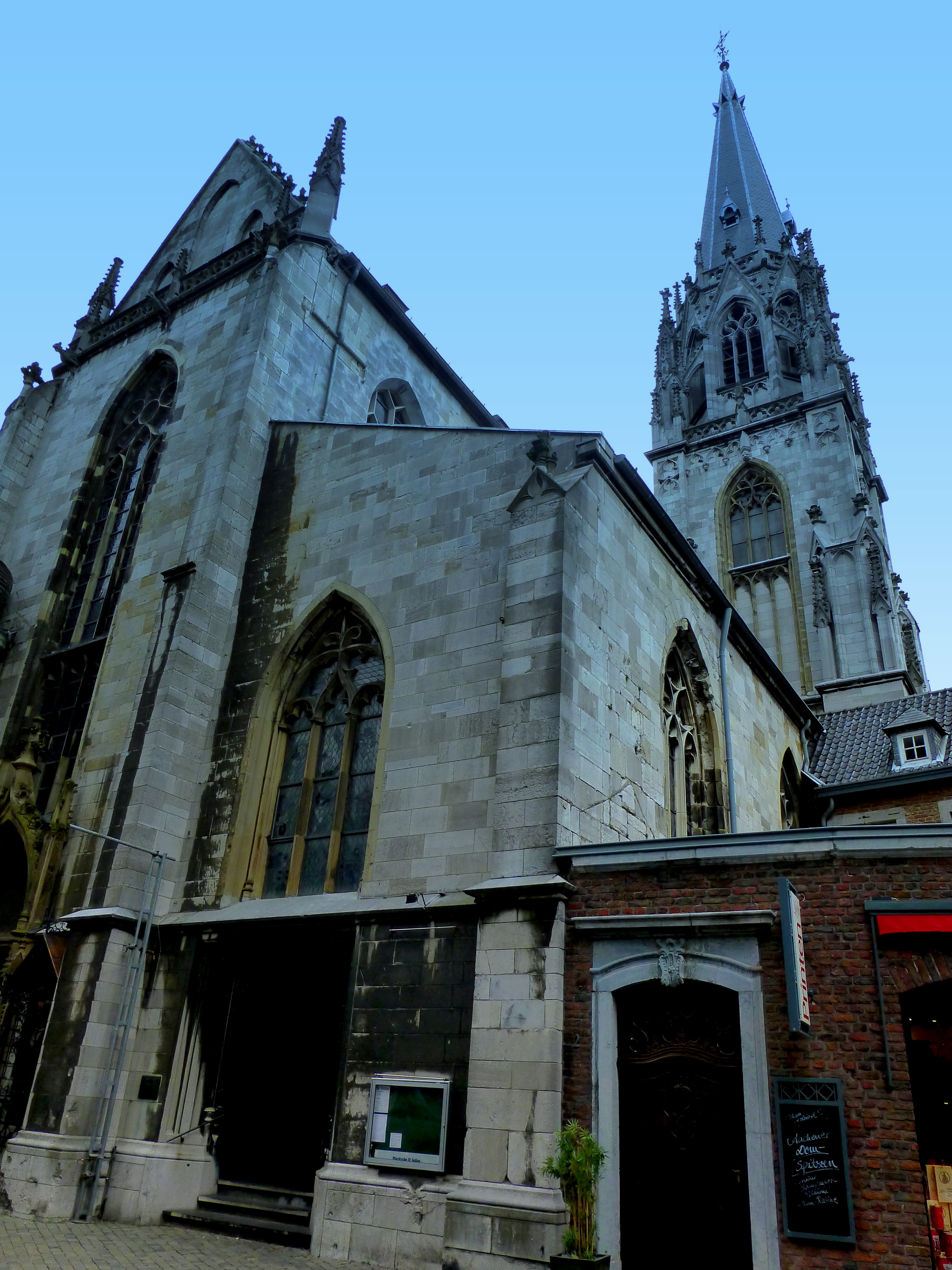Bild des Heiligen Foillan in der Kirche Saint-Nicolas du Roeulx in Fosses
Saint Feuillen
ou Pholien.
Abbé (+ 655)
Frère des saints Irlandais Fursy et Ultan, Saint Feuillan (Faelan, Foillan, Faillan ou Pholien) est né vers l'an 600 sur l'île d'Inchiquin qui se trouve sur Le lac Corrib à l'ouest du Connemara en Irlande.
Lorsqu'il devint adulte, il quitte l'Irlande avec ses deux frères pour évangéliser l'Angleterre. Deux ans plus tard, on le retrouve pour les mêmes raisons en France.
En 650, il arrive à Nivelles (ville de l'actuelle Belgique) où il fait la connaissance de l'abbesse sainte Gertrude qui lui fait don d'une terre sise sur l'actuelle commune de Fosse-la-Ville(*) afin d'y fonder un monastère.
En 651, il doit faire un voyage en France et en profite pour passer par Nivelles afin rendre visite à sainte Gertrude. Il continue sa route et quelques km plus loin il se fait attaquer lui et ses compagnons par des brigands qui les détroussent et les tuent. Feuillien est décapité et ses restes sont enterrés dans une porcherie. On ne trouvera son corps que quelques mois plus tard et il sera ramené à l'abbaye de Nivelles..
Sur le lieu du meurtre, on érige une croix puis, vu le nombre de pèlerins, on construit une chapelle appelée "chapelle de Sénophe". Ce lieu deviendra but de pèlerinages pendant plusieurs siècles.
En 1125, c'est à cet endroit que fut créée une abbaye par les moines prémontrés, ordre qui venait d'être créé par Saint Norbert en France.
A côté de l'abbaye naîtra une ville de Belgique du nom de "Le Roeulx"
(d'après les renseignements communiqués par un internaute)
(*) Un internaute nous précise que Feuillen s'est
installé à Fosses la Ville et non à Le Roeulx. Le Roeulx est l'endroit où il a
été assassiné. Ses reliques se trouvent dans la Collégiale de Fosses la Ville.
Voir aussi:
- l'église Saint-Pholien (paroisse Notre-Dame des Ponts aux Rives d'Outremeuse), connue de tous les lecteurs de Georges Simenon par son récit intitulé "Le pendu de Saint-Pholien" - diocèse de Liège en Belgique
- Saint Feuillen, marche militaire et folklorique septennale à Fosses-la-ville (pays de Namur - Belgique).
- Tous les 7 ans, Fosses-la-Ville vit au rythme des fifres et des tambours pour l'extraordinaire rassemblement de tous les marcheurs de la région. Événement folklorique et populaire incontestable, la Marche Saint-Feuillen est sans doute la plus prestigieuse des marches de l'Entre-Sambre-et-Meuse qui mettent à l'honneur les processions religieuses, les défilés d'hommes en uniformes napoléoniens, les tirs aux canons, les kermesses villageoises, la liesse et les fêtes populaires.
- Feuillen est originaire de cette "terre des saints" que fut l’Irlande au VIIe siècle. Il y naquit à cette époque ainsi que ses frères, Fursy et Ultain, et tous trois nous apparaissent comme des fondateurs d’abbaye et des missionnaires passant d’abord d’Irlande en Angleterre, puis se réfugiant, en compagnie d’autres moines, dans nos régions.
Près de Fosses dans le Brabant, vers 655, saint Feuillen, prêtre et abbé. D’origine irlandaise, frère et compagnon de saint Fursy, et toujours fidèle aux formes de vie monastique de son pays, il établit à Fosses et à Nivelles, un monastère double, l’un pour les hommes, l’autre pour les femmes et, en allant de l’un à l’autre, il fut assassiné par des brigands.
Martyrologe romain
SOURCE : http://nominis.cef.fr/contenus/saint/2109/Saint-Feuillien.html
Saint Foillan, patron saint in Neerlinter church
Tropaire de saint Foillan
Lumière de l'Entre-Sambre-et-Meuse,
tu traversas les mers, vénérable Foillan,
Pour répandre le doux message que le Christ est Ressuscité
Et tu versas ton noble sang pour la gloire de Son Saint Nom.
Aussi aujourd'hui nous te prions d'intercéder
auprès du Christ notre Dieu
Pour le Salut de nos âmes.
SAINT FOILLAN, fondateur de Fosses, martyr
Né en Irlande, de Fintan et de Gelgéhèse, fils et fille de rois, saint Foillan a pour frères les saints Fursy et Ultan. Saint Fursy lui confia l’abbaye qu’il avait fondée en Est-Anglie. Mais Penda, le roi païen des Merciens, pilla l'abbaye ; les moines réussirent à prendre le large sur un navire, avec leurs reliques, leur nécessaire pour célébrer et leurs livres. Saint Foillan et ses compagnons furent accueillis à Péronne (Picardie) par Erchinoald, maire du palais. Puis il se rendit à Nivelles (Belgique) où sainte Gertrude, le mit à contribution pour l’organisation de son monastère, surtout dans le domaine de l’enseignement des Saintes Écritures et de la célébration de l’office divin.
Vers 650, Sainte Gertrude de Nivelles mit à la disposition des moines leur domaine de Fosses où ils construisirent un monastère qui fut placé sous la règle de saint Colomban. Le monastère eut rapidement un grand rayonnement missionnaire. Mais saint Foillan ne le connut pas. En 655, avec trois compagnons, il partit de Nivelles à Fosses (Belgique). En chemin, un bandit, la nuit venue les égara et les mena à une cabane perdue dans la forêt de Seneffe. Les compaires de la cabane accueillir les voyageurs avec une feinte cordialité. Les compagnons du saint, inquiets, ne pouvaient dormir. On récita Matines et Laudes. Saint Foillan parla aimablement à ses hôtes, puis s'assoupit. Alors nos hommes diaboliques, tombèrent sur le saint et le tuèrent avec ses compagnons. Foillan mourut en criant : Deo gratias ! On lui coupa la tête. Le crime resta longtemps ignoré. Les moines cherchaient en vain les disparus. Gertrude priait, jeûnait, lançait des enquêtes. Soixante dix sept jours après le meurtre, le jour anniversaire de la mort de saint Fursy (16 janvier), on retrouva les corps que l’on transporta sur des brancards jusqu’à Nivelles. Le culte du saint abbé se développa rapidement.
Il est invoqué pour demander le beau temps durant les moissons et la guérison des maux de têtes et des maladies nerveuses.
Saint Foillan est fêté le 30 octobre
(Compilation de plusieurs sources)
SOURCE : http://www.eoc-coc.org/accueil/saints-du-mois/octobre/saint-foillan/
7-jaarlijkse Marche Saint-Feuillen in Fosses-la-Ville op zondag 30 september 2012. Photographie : Hoebele
Saint Foillan of Fosses
Also
known as
- Faelan
- Faillan
- Faolan
- Feuillien
- Foalan
- Foelan
- 16 January in
Fosses
- 31 October in
Namur
- 5 November in the dioceses of Mechlin and Tournai
Profile
Brother of Saint Fursey of Peronne and Saint Ultan of Péronne. Travelled with them from Ireland to East Anglia, England c.630 where they worked as missionaries, and established the monastery of Burgh Castle near
Yarmouth. Abbot of the community at Cnoberesburg, Suffolk, England in the 640s, a house founded by his brother Fursey. During a war between the Mercians and
Anglo-Saxons c.650, the house was destroyed, the brothers killed, captured or dispersed. Foillan ransomed
back his brothers, collected the surviving relics, books and liturgical equipage from the house, and travelled to France.
He and his brothers were
welcomed and encouraged in their evangelization by King Clovis II. Foillan founded a monastery at Fosses, diocese of Liege, Belgium, c.653 on land donated by Saint Itta of Nivelles and Saint Gertrude of Nivelles. He served as its abbot, and the area around it grew to the modern town of Le
Roeulx, Belgium. Chaplain and spiritual director at the
house founded by Saint Gertrude. Evangelized the Brabants in the region.
Popular preacher and devoted pastor to his
people. Murdered with three companions on the
road by bandits; as he was travelling on Church business, he is often considered a martyr. His remaining brother, Saint Ultan, then took over as abbot of Fosses.
Born
- murdered 31 October 655 in the forest near Nivelles, Belgium
- bodies
found three months later
- buried at the abbey of Fosses, Belgium
- Irish bishop with a palm of martyrdom
- carrying hot coals in his
vestment for incense
- kneeling,
pierced by a spear
- one of a group of travellers beaten with a club
- praying before the church while the city burns
- refusing the cup at the
table of Pepin to show his refusal of worldly things
- with a crown at his feet to indicate his disdain for worldly things
- with a sword and palm of martyrdom
Readings
Pagan robbers bestowed upon thee the crown of martyrdom, O righteous Foillan, for thy life was a reproach to the impious and cruel men. Having laboured with thy holy brother, our Father Fursey, in East Anglia and later in the Netherlands, pray to God for us, we beseech thee, that both in word and deed our lives may be a missionary witness, that we may be found worthy of His great mercy. – Orthdox dismissal hymn on the feast of Saint Foillan
SOURCE : https://catholicsaints.info/saint-foillan-of-fosses/
Beeld boven de ingang van de Kapittelkerk (Collégiale)
St. Feuillien in Fosses-la-Ville, tijdens de zevenjaarlijkse 'Marche' op zondag
29 september 2019.
St. Foillan
(Irish FAELAN, FAOLAN, FOELAN,
FOALAN.)
Represented in
iconography with a crown at his feet to show that he despised the honours of
the world. He was born in Ireland early in the seventh century
and was the brother of Saints Ultan and Fursey, the latter a famous missionary
who preached the Faith to the Irish, the Anglo-saxons, and the Franks. Foillan, probably in company with
Ultan, went with his brother Fursey when the latter, fleeing from his country
then devastated by foreign invaders, retired to a lonely islands. Fursey soon
went among the Anglo Saxons and built a monastery at Burgh Castle (Cnoberesburg)
in Suffolk, between 634 and 650.
Seized again with the
desire for solitude, Fursey left the monastery in the care of Foillan, who
remained at the head of the community, and had the happiness of once more seeing his
brother Fursey, who, having since gone to the kingdom of the Franks, came to visit him about 650. Soon
a disastrous war broke out between Penda, the Mercian
chief, and Ana, King of the Eastern Anglo-Saxons. Ana having been put to
flight, the monastery of Cnoberesburg fell into the
hand of the enemies. It was pillaged, and its superior, Foillan, barely escaped
death. He hastened to ransom the captive monks, recovered the relics, put the holy books and objects of
veneration on board ship, and departed for the country of the Franks, where his brother Fursey was
buried. He and his companions were well received at Péronne by Erconwald, Mayor
of the Palace. But soon, for some unknown reason, Foillan and his companions
left Péronne and went to Nivelles, a monastery founded by St. Ita and St. Gertrude, wife and
daughter of Duke Pepin I.
Foillan, like so many
other Irishmen who went to the Continent in
the seventh century, was invested with episcopal dignity, having doubtless been
a monastic bishop at Cnoberesburg. He was
therefore of great assistance in the organization of worship, and the holy
books and relics which he brought were great;
treasures for St. Ita and St. Gertrude. As the monastery of Nivelles was under Irish discipline, the companions of
Foillan were well received and lived side by side with the holy women, occupying themselves with the
details of worship under the general direction of the abbess. Through the liberality of Ita,
Foillan was enabled to build a monastery at Fosses, not far from
Nivelles, in the province of Namur. After the death of Ita in 652,
Foillan came one day to Nivelles and sang Mass, on the eve of the feast of
St-Quentin. The ceremony being finished, he resumed his
journey, doubtless undertaken in the interests of his monastery. In the forest of Senege the saint and his companions fell into a
trap set by bandits who inhabited that solitude. They were slain, stripped, and
their bodies concealed. But they were recovered by St. Gertrude, and when she
had taken some relics of the saint his body was borne to the monastery of Fosses, where it was buried
about 655.
Foillan was one of the
numerous Irish travellers who in the course
of the seventh century evangelized Belgium, bringing thither the liturgy and sacred vessels, founding prosperous monasteries, and sharing considerably in the
propagation of the Faith in these countries. Owing to the friendship which
united him with Erconwald, Mayor of the Palace, and with the members of Pepin's
family, Foillan played a preponderant part in Frankish ecclesiastical
history, as shown
by his share in the direction of Nivelles and by the foundation of the monastery of Fosses. It is not
surprising, therefore, that he should be honoured and venerated both at Nivelles and Fosses
and to find at Le Roeulx (Belgium) a monastery bearing his name. As late as
the twelfth century the veneration in which he was held inspired Philippe Le
Harvengt, Abbot of Bonne-Espérance, to compose
a lengthy biography of the saint. He is the patron of Fosses, near
Charieroi. In the Diocese of Namur his feast is celebrated on 31 October,
in the Dioceses of Mechlin and Tournai on 5 November.
Van der Essen, Léon. "St. Foillan." The Catholic Encyclopedia. Vol. 6. New York: Robert Appleton Company, 1909. 31 Oct. 2020 <http://www.newadvent.org/cathen/06123c.htm>.
Transcription. This article was
transcribed for New Advent by Joseph P. Thomas.
Ecclesiastical approbation. Nihil
Obstat. September 1, 1909. Remy Lafort, Censor. Imprimatur. +John M. Farley, Archbishop of New York.
Copyright © 2020 by Kevin Knight. Dedicated to the Immaculate Heart of Mary.
SOURCE : https://www.newadvent.org/cathen/06123c.htm
View from the west of the Gothic revival parish church
of Saint Pholian in the Outremeuse quarter. Liège, Belgium.
St
Foillan
Irish monk and missionary. St Foillan was a brother of
St Fursey, a 7th century bishop. Together they travelled to East Anglia and
established a monastery at Burgh Castle - the remains of which can be seen
today. When Penda, King of Mercia invaded they fled to Neustria in France where
they were well received by the local King, Clovis II.
St Foillan later founded a monastery at Fosses and worked as a missionary in
Brabant. He was killed in 650 by bandits at Serette while on a visitation to
the Irish monastic communities in Lagny and Peronne. The story of the two
brothers was recorded by Bede and several other ancient writers.
Foillan was one of the many Irish missionaries who in the course of the seventh
century evangelised France and Belgium, bringing the liturgy, building churches
and founding many monasteries.
He is honoured and venerated both at Nivelles and Fosses. At Le Roeulx in
Belgium, a monastery bears his name. He is the patron of Fosses, near
Charieroi. In the Diocese of Namur his feast is celebrated on 31 October, in
the Dioceses of Mechlin and Tournai on 5 November.
Chapelle Saint-Feuillien, Hédenge
San Foillano di Fosses Abate
† 31 ottobre 655?
Martirologio
Romano: A Fosses nel Brabante, nel territorio dell’odierno Belgio, san
Foillano, sacerdote e abate, che, di origine irlandese, fu fratello e compagno
di san Furséo e, sempre fedele alle norme monastiche della sua patria, fondò a
Fosses e a Nivelles due monasteri, l’uno maschile e l’altro femminile, e fu
ucciso da alcuni briganti mentre si recava in visita dall’uno all’altro.
San Foillano (lat.
Foilanus; fr. Feuillen, Pholien), martire a Fosses.
SOURCE : http://www.santiebeati.it/dettaglio/75770
The collegiate church St. Foillan, Fosses-la-Ville, Belgium
Voir aussi : http://omniumsanctorumhiberniae.blogspot.com/2014/10/saint-faolan-of-fosses-october-31.html








